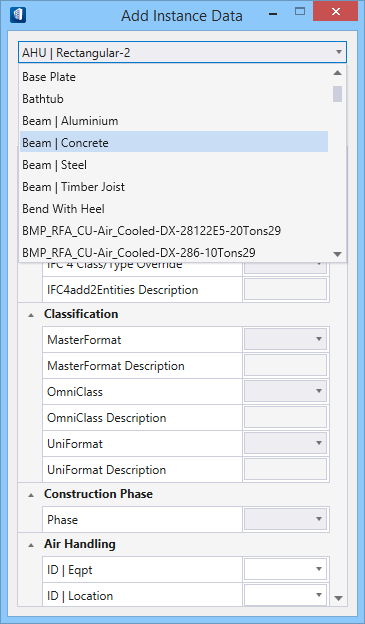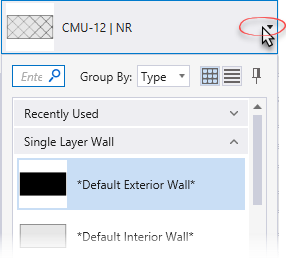Add Instance Data
![]() Used to add
catalog item and instance data to graphic elements to allow such business data
to be included in queries, reports and schedules.
Used to add
catalog item and instance data to graphic elements to allow such business data
to be included in queries, reports and schedules.
Add Instance Data Options tab
| Setting | Description |
|---|---|
| Use Model Properties | Enabled when the active model has the
option enabled in its
model properties (i.e. Model Properties > Cell > Can
be Placed as AnnotationCell is True).
When on, catalog data is placed with each cell instance. When off, catalog data is added to existing selected cells. |
| Use Fence | Enabled when there is an active fence. When on, catalog item instances are selected according to the selected Fence mode. |
| Fence Mode |
|
Add Instance Data Properties
| Setting | Description |
|---|---|
| Catalog Type Selector | Displays catalog types hierarchically arranged based on Building discipline, making it easier to navigate to desired catalog types. All Catalog Types available in the application, including imported ones like the RFAs, if any are listed here. Selects the catalog type (e.g. Door, Window, etc) which populates the Instance Data Properties. Selections made here updates the Catalog Item Selector combo box below it. |
| Catalog Item Selector |
Used to select from available
Catalog Items. The
Catalog Item Selector combo box contains
several options and settings designed to make it easier to find the exact
catalog item you need to place/change.
The
Catalog Item list also includes user
defined assemblies, and RFA catalog items, if any.
|
| Catalog Tools |
A split button located to the right of the
Catalog Item Selector contains tools to
assist with managing catalog data prior to placement of selected catalog items.
Note: The
Save Catalog Item and
Save Catalog Item As... tools perform
administrative tasks on DataGroup System catalogs. Administrators and users may
want to hide the tool icons to avoid incidental or unwanted changes to their
firm's dataset by setting the user configuration variables
BB_CATALOGITEM_ADMIN_IN_PLACECMDS
and
BB_CATALOGITEM_SAVEAS_IN_PLACECMDS to "0", respectively.
|
| Properties list | Used to manage catalog item properties during
attaching instance data. Catalog item properties define the catalog item
instance in the model, and are accountable in the DataGroup System data
management tools. You can place a catalog item with its default property values
or you can change property values as needed, add an instance in the model, and
optionally save the changes to the catalog.
The Properties combo box contains tools for sorting and searching the properties list:
Information in the Value column rows can be completed by selecting the applicable cell to activate an editor field, an option menu, or a pop up dialog. This data is written to the element properties. Properties displayed with grey text are read only. The dividing bar between the Property, and Value columns can be moved to change the width of either area, or resize the dialog. A vertical and a horizontal scroll bars are available to scroll and adjust Properties panel viewing and the display of data. Note: The property
categories listed in the panel vary depending upon the active catalog instance
(and the discipline the catalog item belongs). Unlike in placement, the
properties in add instance workflow have limited options, e.g. the Mechanical
context menus and settings through context activated dialog, etc.)
|





 (
( (
( (
( (
( (
( (
( (
( (
( (
( (
( (
( (
(